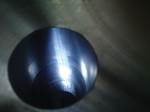Hole quality defined
In the aerospace industry, drilled hole quality is defined by ISO 286: System of Limits and Fits, a coordinated system of hole and shaft tolerances that is used in both engineering and production.
In manufacturing — and the prerequisite engineering — it is not possible to make components to an exact size every time. Thus, the amount the actual molded component’s size may deviate from the target dimensions must be known and listed along with its nominal measurements. A component’s maximum and minimum permissible size are known as its limits and their difference is termed the tolerance. These definitions also apply to the holes drilled to accommodate fasteners when joining multiple components to form an assembly.
ISO 286: System of Limits and Fits is a coordinated system of hole and shaft tolerances that is used in both engineering and production. It is defined and maintained by the International Organization for Standardization (ISO, Geneva, Switzerland), an independent, nongovernmental organization that comprises members from the national standards bodies of 161 countries. The ISO 286 standard states, “hole basis fits [as opposed to shaft basis fits] have four preferred hole tolerances (H11, H9, H8, and H7).” Hole basis fits are used when holes are made with standard machine tools (drills, reamers or end mills). The above hole tolerances are used to indicate the precision of drilled holes in aerostructures.
Fig. 1 shows a typical hole size and tolerance designation where size is most commonly given in milimeters (mm). The smaller the IT number, the more precise the hole diameter. Cutting-tool manufacturers often use H8, H7, etc. interchangeably with IT8, IT7, etc., to describe the precision of drilled holes.
According to Dr. Peter Mueller-Hummel, senior manager for the aerospace and composites business unit of Mapal (Aalen, Germany), “the standard for drilled hole tolerance in aerospace metals is H7, meaning that the diameter does not vary more than .010 mm [0.0004 inch or 0.4 mil].” He notes that the hole tolerance in The Boeing Co.’s (Chicago, Ill.) 787 Dreamliner program was initially relaxed to H8, or ±0.018 mm (0.0007 inch or 0.7 mil), but because the holes being drilled still could not consistently meet that, the tolerance was dropped again to H9 at ±0.04 mm (0.002 inch or 2.0 mil).
The other measure of hole drilling precision given is CPK, or Cpk, which is defined as process capability index, a statistical tool that measures the ability of a process to meet specifications. It compares the process data distribution — e.g., hole diameter — to the specification limits and predicts future performance. A CPK >1.3 is required for “reliable and safe” drilling operations in aerostructures, according to Mueller-Hummel, and 1.7 is necessary for OEM qualification (a higher number indicates better performance). Thus, the CPK of 2.4 that Mapal reports for its new tool in the dry drilling of a wingbox assembly’s stacked materials is impressive.
Related Content
-
From the CW Archives: Drilling is not for the faint of heart
This edition of From the CW Archives revisits CW’s first plant tour — a visit to the F-35 FAL in Fort Worth, Texas — and a story by Ginger Gardiner a few years later. Both offer lessons on how to perform stacked drilling through composite and metallic materials.
-
Ideko research validates robotic solution for clean, precise composites machining
Designed through the European Fibremach project, the equipment provides a greater increase in precision and machining efficiency and integrates a monitoring system that ensures part quality.
-
Optimizing machining for composites: Tool designs, processes and Industry 4.0 systems
Hufschmied moves beyond optimized milling and drilling tools to develop SonicShark inline quality control system and Cutting Edge World cloud platform for optimized tool use and processes.
















